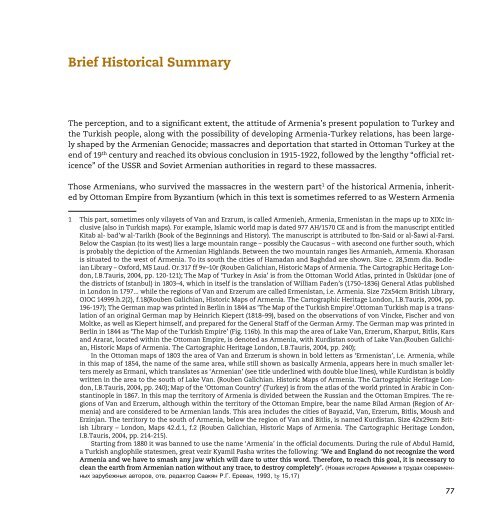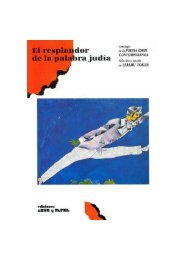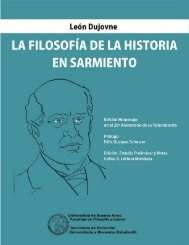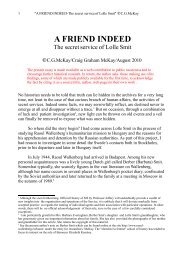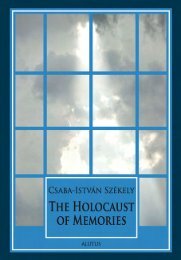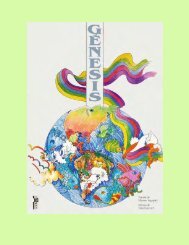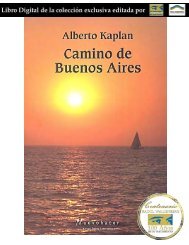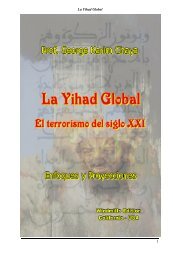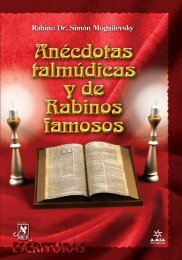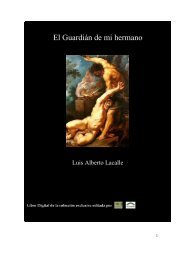Speaking to One Another - The International Raoul Wallenberg ...
Speaking to One Another - The International Raoul Wallenberg ...
Speaking to One Another - The International Raoul Wallenberg ...
- No tags were found...
You also want an ePaper? Increase the reach of your titles
YUMPU automatically turns print PDFs into web optimized ePapers that Google loves.
Brief His<strong>to</strong>rical Summary<strong>The</strong> perception, and <strong>to</strong> a significant extent, the attitude of Armenia’s present population <strong>to</strong> Turkey andthe Turkish people, along with the possibility of developing Armenia-Turkey relations, has been largelyshaped by the Armenian Genocide; massacres and deportation that started in Ot<strong>to</strong>man Turkey at theend of 19 th century and reached its obvious conclusion in 1915-1922, followed by the lengthy “official reticence”of the USSR and Soviet Armenian authorities in regard <strong>to</strong> these massacres.Those Armenians, who survived the massacres in the western part 1 of the his<strong>to</strong>rical Armenia, inheritedby Ot<strong>to</strong>man Empire from Byzantium (which in this text is sometimes referred <strong>to</strong> as Western Armenia1 This part, sometimes only vilayets of Van and Erzrum, is called Armenieh, Armenia, Ermenistan in the maps up <strong>to</strong> XIXc inclusive(also in Turkish maps). For example, Islamic world map is dated 977 AH/1570 CE and is from the manuscript entitledKitab al- bad’w al-Tarikh (Book of the Beginnings and His<strong>to</strong>ry). <strong>The</strong> manuscript is attributed <strong>to</strong> Ibn-Said or al-Šawi al-Farsi.Below the Caspian (<strong>to</strong> its west) lies a large mountain range – possibly the Caucasus – with asecond one further south, whichis probably the depiction of the Armenian Highlands. Between the two mountain ranges lies Armanieh, Armenia. Khorasanis situated <strong>to</strong> the west of Armenia. To its south the cities of Hamadan and Baghdad are shown. Size c. 28,5mm dia. BodleianLibrary – Oxford, MS Laud. Or.317 ff 9v–10r (Rouben Galichian, His<strong>to</strong>ric Maps of Armenia. <strong>The</strong> Car<strong>to</strong>graphic Heritage London,I.B.Tauris, 2004, pp. 120-121); <strong>The</strong> Map of ‘Turkey in Asia’ is from the Ot<strong>to</strong>man World Atlas, printed in Üsküdar (one ofthe districts of Istanbul) in 1803–4, which in itself is the translation of William Faden’s (1750–1836) General Atlas publishedin London in 1797... while the regions of Van and Erzerum are called Ermenistan, i.e. Armenia. Size 72x54cm British Library,OIOC 14999.h.2(2), f.18(Rouben Galichian, His<strong>to</strong>ric Maps of Armenia. <strong>The</strong> Car<strong>to</strong>graphic Heritage London, I.B.Tauris, 2004, pp.196-197); <strong>The</strong> German map was printed in Berlin in 1844 as ‘<strong>The</strong> Map of the Turkish Empire’.Ot<strong>to</strong>man Turkish map is a translationof an original German map by Heinrich Kiepert (1818–99), based on the observations of von Vincke, Fischer and vonMoltke, as well as Kiepert himself, and prepared for the General Staff of the German Army. <strong>The</strong> German map was printed inBerlin in 1844 as ‘<strong>The</strong> Map of the Turkish Empire’ (Fig. 116b). In this map the area of Lake Van, Erzerum, Kharput, Bitlis, Karsand Ararat, located within the Ot<strong>to</strong>man Empire, is denoted as Armenia, with Kurdistan south of Lake Van.(Rouben Galichian,His<strong>to</strong>ric Maps of Armenia. <strong>The</strong> Car<strong>to</strong>graphic Heritage London, I.B.Tauris, 2004, pp. 240);In the Ot<strong>to</strong>man maps of 1803 the area of Van and Erzerum is shown in bold letters as ‘Ermenistan’, i.e. Armenia, whilein this map of 1854, the name of the same area, while still shown as basically Armenia, appears here in much smaller lettersmerely as Ermani, which translates as ‘Armenian’ (see title underlined with double blue lines), while Kurdistan is boldlywritten in the area <strong>to</strong> the south of Lake Van. (Rouben Galichian. His<strong>to</strong>ric Maps of Armenia. <strong>The</strong> Car<strong>to</strong>graphic Heritage London,I.B.Tauris, 2004, pp. 240); Map of the ‘Ot<strong>to</strong>man Country’ (Turkey) is from the atlas of the world printed in Arabic in Constantinoplein 1867. In this map the terri<strong>to</strong>ry of Armenia is divided between the Russian and the Ot<strong>to</strong>man Empires. <strong>The</strong> regionsof Van and Erzerum, although within the terri<strong>to</strong>ry of the Ot<strong>to</strong>man Empire, bear the name Bilad Arman (Region of Armenia)and are considered <strong>to</strong> be Armenian lands. This area includes the cities of Bayazid, Van, Erzerum, Bitlis, Moush andErzinjan. <strong>The</strong> terri<strong>to</strong>ry <strong>to</strong> the south of Armenia, below the region of Van and Bitlis, is named Kurdistan. Size 42x29cm BritishLibrary – London, Maps 42.d.1, f.2 (Rouben Galichian, His<strong>to</strong>ric Maps of Armenia. <strong>The</strong> Car<strong>to</strong>graphic Heritage London,I.B.Tauris, 2004, pp. 214-215).Starting from 1880 it was banned <strong>to</strong> use the name ‘Armenia’ in the official documents. During the rule of Abdul Hamid,a Turkish anglophile statesmen, great vezir Kyamil Pasha writes the following: ‘We and England do not recognize the wordArmenia and we have <strong>to</strong> smash any jaw which will dare <strong>to</strong> utter this word. <strong>The</strong>refore, <strong>to</strong> reach this goal, it is necessary <strong>to</strong>clean the earth from Armenian nation without any trace, <strong>to</strong> destroy completely’. (Novaq is<strong>to</strong>riq Armenii v trudah sovremennyhzarubejnyh av<strong>to</strong>rov, otv. redak<strong>to</strong>r Saakqn R.G. Erevan, 1993, էջ 15,17)77


